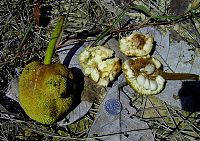
Photo from wikipedia
The discharge of large amounts of wastewater carrying various contaminants from many anthropogenic activities into the receiving water environment is a multidimensional issue negatively affecting the ecological system and natural… Click to show full abstract
The discharge of large amounts of wastewater carrying various contaminants from many anthropogenic activities into the receiving water environment is a multidimensional issue negatively affecting the ecological system and natural balance in many ways. The removal of pollutants by the biologically-originated materials is an emerging area of interest due to profoundly their environmental friendliness, renewability, sustainability, readily availability, biodegradability, multiplicity, low (or no) economic cost, high affinity, capacity, and stability. In the present study, a popular ornamental plant, Pyracantha coccinea M. J. Roemer, was converted into a green sorbent material with the goal to effectively remove a widespread contaminant (synthetic dye, C. I. Basic Red 46) from synthetic wastewater. The physicochemical characteristics of the prepared biosorbent were determined by the instrumental analyses of FTIR and SEM. The batch experiments of various operational influence parameters were conducted to maximize the system efficiency. The wastewater remediation behavior by the material was investigated by the kinetics, thermodynamics, and isotherm experiments. The biosorbent had a non-uniform and rough surface architecture with a diversity of functional groups. The maximum remediation yield was achieved with the contact duration of 360 min, the pollutant load of 30 mg L-1, the pH of 8, and the biosorbent quantity of 10 mg (0.1 g L-1). The kinetics of the contaminant removal showed good agreement with the pseudo-second-order model. Thermodynamics study indicated that the treatment process was spontaneous and occurred by physisorption. Langmuir model fitted the isotherm data of the biosorption operation well and the maximum pollutant cleanup capacity of the material was determined to be 169.354 mg g-1. These outcomes showed that P. coccinea M. J. Roemer could be used as a promising material for low-cost and green treatment of wastewater.
Journal Title: International journal of phytoremediation
Year Published: 2023
Link to full text (if available)
Share on Social Media: Sign Up to like & get
recommendations!